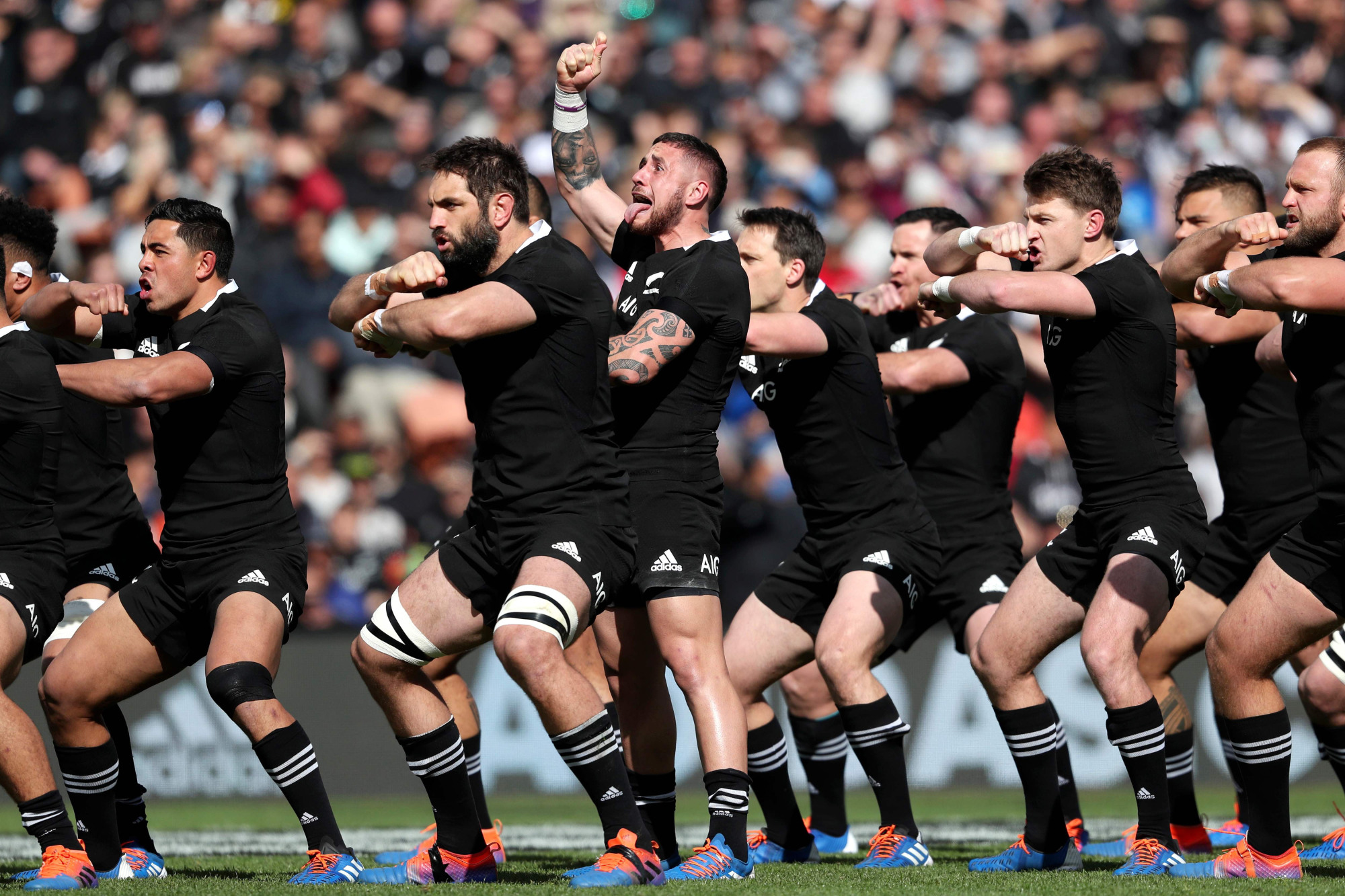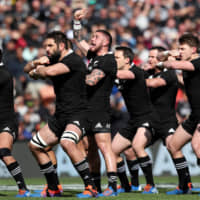The crowd is erupting in anticipation. The national anthems of both teams have just concluded and all eyes are now firmly fixed on the action about to unfold on the pitch below.
The New Zealand All Blacks move into position near the halfway line. Their formation is in the shape of a spearhead, ready to thrust through enemy lines.
The leader starts to pace back and forth among the ranks while delivering a rousing speech to his troops.
He is speaking Maori, a language that is similar in pronunciation to Japanese.
His words fire up the warriors as they growl at their foes, eyes bulging and tongues protruding.
The opposition stands 15 meters away facing the men in black, arms around shoulders, unified, returning stone-cold stares.
And then it begins.
Each player dressed in black moves in unison, laying down a challenge through heated words.
A mixture of aggressive movements ensues. The slapping of thighs, chests and elbows punctuated by outstretched fists before accumulating in one final salvo of defiance.
The spectators roar their approval of the haka as the All Blacks briefly eyeball their opponents before dispersing. The referee blows his whistle shortly after and the match gets underway.
The haka is synonymous with the All Blacks and takes its origin from the indigenous Maori people of New Zealand.
In fact, haka is the generic term for all Maori dance but the "Ka Mate" haka is the one most recognized around the world.
It is a prematch ritual that embodies passion, intensity, brute determination and precision, all of which have been attributes of the New Zealand national rugby team.
On the surface, the haka performed by the All Blacks can appear to be an intimidating war dance, a means to belittle and provoke the opposition as described above. But is that the actual case?
To answer that question, we need to go back to the early nineteenth century when Maori chieftain Te Rauparaha composed this haka.
Under the protection of chief Te Wharerangi, he managed to evade his enemies by hiding in a kumara (native sweet potato) storage pit.
As his attackers approached his hiding spot, he breathed, "Ka mate, ka mate" (I may die, I may die). His concealment was not discovered, however, and Te Rauparaha is said to have muttered, "Ka ora, Ka ora" (I may live, I may live).
Once the war party had passed by, he emerged from the darkness unharmed and exclaimed: "Tenei te tangata puhuruhuru" (This is the hairy man-referring to his protector), "nana nei i tiki mai" (who saved me).
He continued, "whakawhiti te ra" (the sun shines again). The sun represents life and Te Rauparaha was acknowledging that he was extremely lucky to be alive.
Te Rauparaha completes the haka by reaffirming his jubilation from escaping certain death. "A upane, Ka upane" (Rise up, rise up again), "Whiti te ra. hi!" (the sun shines on me, rise!).
Based on the words created by the Maori chieftain around 1820, it is obvious that the All Blacks' Ka Mate haka is not a bloodthirsty battlecry, nor is it used to disrespect opponents.
It is instead a chant that evokes a rebirth, a chance to rise to the occasion, to believe in oneself and your teammates and most importantly, to never give up no matter how drastic the situation may be.
The performers of this haka are forced to reflect inwardly and prepare themselves for the challenge that lies ahead.
The haka is an integral part of the All Blacks' identity and it is what makes the New Zealand rugby side true to itself, underpinning the core values which are closely associated to the Maori term mana.
Mana encompasses a wide range of meanings that have defined Maori culture and history. To have mana is to possess qualities such as honor, respect, spiritual power and courage, but also humility. Good deeds on or off the field can increase a person's mana, however bringing the team into disrepute or being caught up in a scandal can take it all away.
For those reasons, maintaining one's mana is as treasured to the All Blacks as it is to the Maori.
In August 2005, before the Tri-nations match between the All Blacks and the Springboks in New Zealand, a new haka was unveiled called "Kapa o Pango" which translates to "the team in black."
It was written specifically for the All Blacks by Derek Lardelli, an expert on Maori customs and culture.
Lardelli explained, "This haka, in particular, is not a war dance. It's ceremonial. It's about building the person's confidence inwardly, their spiritual side, and then making that spiritual side connect through the soul and coming out through the eyes and the gestures and the hands. So it's a preparation of your physical side as well as your spiritual side prior to doing something very important."
The Kapa o Pango is only performed on special occasions and is not intended to replace the Ka Mate dance.
Rather it is intended to add another dimension to the pre-existing haka and enlighten the players about the legacy behind the black jersey.
Center Aaron Mauger, who performed the Kapa o Pango for the first time said: "I think the important thing about the haka is that it talks about us, our time, as All Blacks. You don't get a lot of time in the jersey so you cherish every moment you have. And it's about that, doing the best you can do when you pull the jersey on. It's also about the traditions of All Black rugby, the black jersey, and the silver fern."
New Zealand will open its World Cup campaign against South Africa on Sept. 21 at International Stadium Yokohama.
This crucial Pool B clash promises to be the main feature of the group stages, which may compel the All Blacks to perform their Kapa o Pango haka.
It will be a sight to behold and as Springbok captain John Smit said of the debut performance in 2005, "To stand there and watch it for the first time was a privilege."




















With your current subscription plan you can comment on stories. However, before writing your first comment, please create a display name in the Profile section of your subscriber account page.